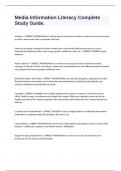Media Information Literacy Complete
Study Guide.
Audience - CORRECT ANSWER Refers to the group of consumers for whom a media text was constructed
as well as anyone else who is exposed to the text.
Refers to the group of people to whom a media text is specifically addressed because of a set of
characteristics that they share, such as age, gender, profession, class, etc. - CORRECT ANSWER Target
audience
Active audience - CORRECT ANSWER Refers to a theory that people receive and interpret media
messages in the light of their own history, experience and perspective so that different groups of people
may interpret the same message in different ways
Audio Information and Media - CORRECT ANSWER Refers to materials, programs, applications and the
like that teachers and students use to formulate new information to aid learning through the use,
analysis, evaluation and production of sound.
Copyright - CORRECT ANSWER A set of rights granted to the author or creator of a work, to restrict
others' ability to copy, redistribute and reshape the content. Rights are frequently owned by the be
bought and sold on the market.companies who sponsor the work rather than the creators themselves
and can
Creative Forms of Multimedia - CORRECT ANSWER it refers to digital (refer to multimedia information
and media) or traditional types like portfolio, flip charts, etc.
Cyber Bullying - CORRECT ANSWER Refers to the use of information technology to harm or harass other
people in a deliberate, repeated, and hostile manner. (Wikipedia)
Design Principle and Elements - CORRECT ANSWER Refers to the set of rules and criteria for the
production of new media and information.
, Digital Divide - CORRECT ANSWER Refers to the gap between groups, broadly construed, in terms of
access to, use of, or knowledge, skills and even attitude in
Electronic portfolio - CORRECT ANSWER Refers to a collection of electronic evidence assembled and
managed by a user, usually on the Web. Such electronic evidence may include inputted text, electronic
files, images, multimedia, blog entries, and hyperlinks. (Wikipedia)
Fair Use - CORRECT ANSWER Refers to the limitation and to the exclusive right granted by copyright law
to the author of a creative work. Examples of fair use include commentary, search engines, criticism,
news reporting, research, teaching, library archiving and scholarship. (UNESCO MIL Curriculum for
Teachers)
Indigenous media - CORRECT ANSWER Any form of media that is created and controlled by a
community, either a geographic community or a community of identity or interest. Community media
are separate from either private (commercial) media, state-run media, or public broadcast media.
Community media are increasingly recognized as a crucial element in a vibrant and democratic media
system. (Wikipedia)
Information - CORRECT ANSWER A broad term that can cover data, knowledge derived from study,
experience, or instruction, signals or symbols. In the media world, information is often used to describe
knowledge of specific events or situations that has been gathered or received by communication,
intelligence or news.
Information Literacy - CORRECT ANSWER Refers to the abilities to recognize when information is needed
and to locate, evaluate, effectively use, and communicate information in its various formats.
Internet - CORRECT ANSWER A global system of interconnected computer networks that use the
standard Internet Protocol Suite (TCP/IP) to serve billions of users worldwide. It is a network of networks
that consists of millions of private, public, academic, business, and government of electronic and optical
networking technologies.
Internet Addiction - CORRECT ANSWER Refers to an excessive or poorly controlled preoccupations, urges
or behaviors regarding computer use and internet access that lead to impairment or distress. (US
National Library of Medicine, National Institute of Health)




